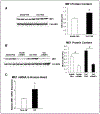Enhanced Redox State and Efficiency of Glucose Oxidation With miR Based Suppression of Maladaptive NADPH-Dependent Malic Enzyme 1 Expression in Hypertrophied Hearts
- PMID: 29386187
- PMCID: PMC6463492
- DOI: 10.1161/CIRCRESAHA.118.312660
Enhanced Redox State and Efficiency of Glucose Oxidation With miR Based Suppression of Maladaptive NADPH-Dependent Malic Enzyme 1 Expression in Hypertrophied Hearts
Abstract
Rationale: Metabolic remodeling in hypertrophic hearts includes inefficient glucose oxidation via increased anaplerosis fueled by pyruvate carboxylation. Pyruvate carboxylation to malate through elevated ME1 (malic enzyme 1) consumes NADPH necessary for reduction of glutathione and maintenance of intracellular redox state.
Objective: To elucidate upregulated ME1 as a potential maladaptive mechanism for inefficient glucose oxidation and compromised redox state in hypertrophied hearts.
Methods and results: ME1 expression was selectively inhibited, in vivo, via non-native miR-ME1 (miRNA specific to ME1) in pressure-overloaded rat hearts. Rats subjected to transverse aortic constriction (TAC) or Sham surgery received either miR-ME1 or PBS. Effects of ME1 suppression on anaplerosis and reduced glutathione (GSH) content were studied in isolated hearts supplied 13C-enriched substrate: palmitate, glucose, and lactate. Human myocardium collected from failing and nonfailing hearts during surgery enabled RT-qPCR confirmation of elevated ME1 gene expression in clinical heart failure versus nonfailing human hearts (P<0.04). TAC induced elevated ME1 content, but ME1 was lowered in hearts infused with miR-ME1 versus PBS. Although Sham miR-ME1 hearts showed no further reduction of inherently low anaplerosis in normal heart, miR-ME1 reduced anaplerosis in TAC to baseline: TAC miR-ME1=0.034±0.004; TAC PBS=0.081±0.005 (P<0.01). Countering elevated anaplerosis in TAC shifted pyruvate toward oxidation in the tricarboxylic acid cycle. Importantly, via the link to NADPH consumption by pyruvate carboxylation, ME1 suppression in TAC restored GSH content, reduced lactate production, and ultimately improved contractility.
Conclusions: A maladaptive increase in anaplerosis via ME1 in TAC is associated with reduced GSH content. Suppressing increased ME1 expression in hypertrophied rat hearts, which is also elevated in failing human hearts, reduced pyruvate carboxylation thereby normalizing anaplerosis, restoring GSH content, and reducing lactate accumulation. Reducing ME1 induced favorable metabolic shifts for carbohydrate oxidation, improving intracellular redox state and enhanced cardiac performance in pathological hypertrophy.
Keywords: glucose; heart failure; hypertrophy; metabolism; microRNAs.
© 2018 American Heart Association, Inc.
Figures






References
Publication types
MeSH terms
Substances
Grants and funding
LinkOut - more resources
Full Text Sources
Other Literature Sources
Miscellaneous

